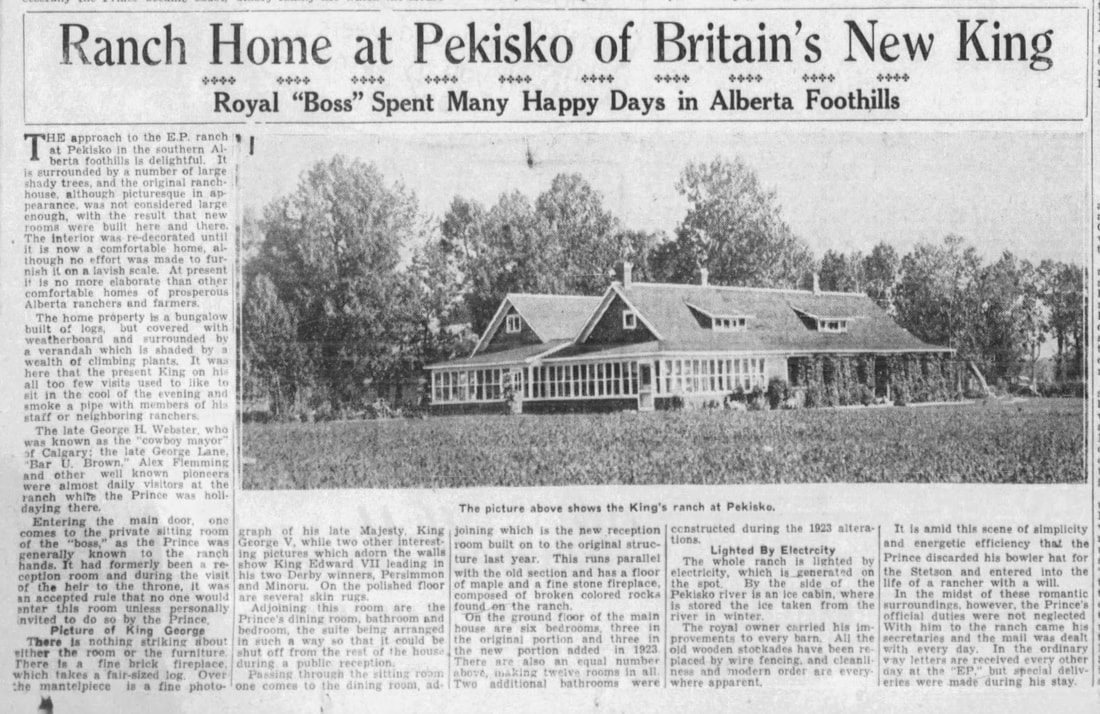 EP Ranch, Pekisko, Alberta, 1936. Calgary Daily Herald, Jan 21, 1936
EP Ranch, Pekisko, Alberta, 1936. Calgary Daily Herald, Jan 21, 1936 See the Heroes, Heroines, and History blog for images and newspapers that tell the story about how the ranch has survived after Edward.
 EP Ranch, Pekisko, Alberta, 1936. Calgary Daily Herald, Jan 21, 1936 EP Ranch, Pekisko, Alberta, 1936. Calgary Daily Herald, Jan 21, 1936 The final post in my series about the EP Ranch in Alberta, Canada, concludes with the coronation, abdication, and death of King Edward VIII.
See the Heroes, Heroines, and History blog for images and newspapers that tell the story about how the ranch has survived after Edward. My series on the EP Ranch in Alberta, Canada, goes Hollywood on Sept 5th as I post the use of the ranch as a film location. It was first used for some of the scenes in the western silent film The Calgary Stampede back in 1925. Recently, it was used as one of the locations for Clint Eastwood's award-winning film Unforgiven.
Join me at the Heroes, Heroines and History blog for photos, a video, and more information about the Movie Location EP Ranch. In 1923, Edward, Prince of Wales, returns to the ranch he bought on his previous visit to Alberta in 1919, and spends a month learning how to be a rancher while still fulfilling the duties of being heir to Britain's royal throne. If you haven't guessed, I'm over at the Heroes, Heroines, and History blog with my second post on Alberta's EP Ranch. If you have a few minutes, stop by and check out the historical photos of the post, EP Ranch Royal Visit 1923. I'm excited to announce the start of a new series on Alberta's "Rancher King" on the 5th of every month over on the Heroes, Heroines and History blog. The first post introduces the UK's Edward Prince of Wales and the E.P. Ranch which he bought in 1919 in Southern Alberta when he was still a young man. Yes, this is the same Edward who would become King on January 1936...and then abdicate his throne in December of that same year and exchange it for the woman he loved. Join me as I show you a small part of Edward Prince of Wales and a special place in his heart. What is a beach machine? That's what I wondered when I worked on a recent post about a seaside bandstand and found several photographs and postcards about these cute little houses on wheels. I dove into the research which led me to structures as you see above that were used in the past few centuries to allow people - royals and commoners - to bathe in privacy. Join me at Heroes, Heroines and History as I venture into the adventurous world I've entitled, Rise of the Bathing Machines Part 1. I love research and my post, From Ice Slide to Roller Coaster, over at the Heroes, Heroines and History blog, is full of interesting images of what turns out to be the beginnings of roller coasters.
And if thrill rides aren't your thing, drop in and see what luxury awaited the pleasure-seekers of Catherine the Great's court after a day on the slides. Hope to see you there. This is Part 3 of my Inkwell Inspiration series on sleighs: • Part 1 is about 19th century adult and Santa sleighs. • Part 2 is about 19th centurychildren's sleighs. Today's post is about 18th and 19th century royal sleighs with a token humorous nod to the 20th century. Take this Russian royal sledge for example: This sleigh is housed in the Kremlin in Moscow, where we find the oldest of the royal Russian conveyances. It is from the 18th century and was one of many to carry the royal court from city to city. For example, when Catherine the Great (1729-1796) made her trip from St. Petersburg to Moscow for her coronation, she did it in 13 days in a sleigh similar to this. According to the book, Russian Imperial Style, by Laura Cerwinske, Catherine’s sleigh was a "palace on runners! It contained a salon, library and bedroom all warmed by porcelain stoves. It had six windows and was wide enough for 8 people to pass abreast! Behind her sleigh was a procession of 19,000 horses and 14 large sleighs and 184 smaller ones carrying the royal court." The questions for discussion over at the Inkwell today are: - Have you ever visited a foreign museum? - Which one and why? - Which one would you like to visit if you had a chance? I hope you enjoy your visit. Anita Mae. |
Archives
December 2021
Categories
All
|
